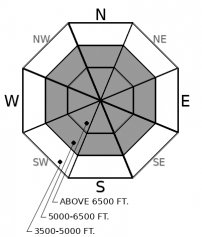| Sunday | Sunday Night | Monday | |
|---|---|---|---|
| Cloud Cover: | Mostly cloudy | Mostly Cloudy | Partly Cloudy |
| Temperatures: | 25 to 30 deg. F. | -3 to 2 deg. F. | 13 to 18 deg. F. |
| Wind Direction: | Northwest | North | North |
| Wind Speed: | 5 to 15 mph | 5 to 15 mph | 0 to 10 mph |
| Snowfall: | 2 to 5" in. | 0 in. | 0 in. |
| Snow Line: | Decreasing to 1000 ft | 0 ft | 0 ft |
Whitefish Range
Swan Range
Flathead Range and Glacier National Park
How to read the forecast
Over a foot of snow and strong winds have created dangerous avalanche conditions. Numerous natural and human-triggered avalanches failed yesterday, and these slabs continue to thicken and become more widespread. Bring a conservative mindset to the backcountry today and allow the snowpack time to adjust. Shooting cracks, whumphs, recent avalanches, and thick drifts are all clear signs to stay off of terrain steeper than 35 degrees.

3. Considerable
?
Above 6500 ft.
3. Considerable
?
5000-6500 ft.
1. Low
?
3500-5000 ft.
- 1. Low
- 2. Moderate
- 3. Considerable
- 4. High
- 5. Extreme
-
Type ?
-
Aspect/Elevation ?

-
Likelihood ?CertainVery LikelyLikelyPossible
 Unlikely
Unlikely -
Size ?HistoricVery LargeLargeSmall

In the past 24 hours, over a foot of increasingly dense snow has accumulated, accompanied by strong southwest winds. Observers yesterday reported shooting cracks and easily triggered slabs in leeward terrain features. With additional snowfall overnight and today, these slabs are growing thicker and expanding to more terrain. Consider terrain consequences while carefully assessing the amount and bonding of the storm snow before traveling on any slope steeper than 35 degrees. Wind-loaded features will be harboring larger and more dangerous slabs.
-
Type ?
-
Aspect/Elevation ?

-
Likelihood ?CertainVery LikelyLikelyPossible
 Unlikely
Unlikely -
Size ?HistoricVery LargeLargeSmall

Dense persistent slabs several feet thick or more will be more reactive today given the rapid load from snowfall and intense wind transport. These avalanches can break on deep weak layers and produce surprisingly large avalanches. Slopes with a thinner and weaker snowpack are most suspect. Because this type of problem is so challenging to assess and manage, give yourself a wide margin for error in your terrain choices. You can easily avoid this hazard by choosing terrain less than about 35 degrees that doesn't undercut steeper terrain above you.
2018 is going out with a bang! The storm has produced 1.2" to 1.6" of Snow Water Equivalent, most of which fell in the past 24 hours. Another round of heavy snow is expected this morning as the cold front passes through. Storm totals will be in the ballpark of 10" to 20" around our forecast area when all is said and done. Temperatures increased as the storm raged on last night, making for an upside-down or "top-heavy" storm slab problem. Winds were cranking yesterday afternoon with gusts near 50 mph at exposed locations. The storm snow came in on low-density snow that was already producing avalanche activity and shooting cracks during the early phase of the storm. Yesterday, observers in the Flathead Range and Apgar Range reported tender wind slabs and shooting cracks at mid and upper elevations (Example A, Example B). Since then, another ~10" has accumulated, slabs have thickened, and the naughty list now includes sheltered slopes and windward aspects as well. The nice list is now slopes less than 35 degrees or low elevations (If you don't mind getting wacked in the face by alders). Natural avalanche activity will wind down after the cold front pushes through, but human triggered avalanches will remain likely.
Going into this storm, some terrain was showing deep and relatively strong snowpack structures, while areas holding shallower snowpacks were still presenting us with unnerving weak layers. These layers exist in the middle and bottom of the snowpack, a product of our November dry spells. A rapid load paired with huge wind transport will put our persistent slab structure to the test again. Your weight, or slides in the upper snowpack, have potential to trigger deep weak layers on some slopes today. If an avalanche breaks near the ground, it will be large enough to bury you or snap trees - not something you want to tangle with. Patience is your best weapon.
A cold front is swinging south across the US/Canada border early this morning. This will produce a band of heavy snowfall and bring cold temperatures and a downturn in wind speeds in its wake.
This forecast applies only to backcountry areas outside established ski area boundaries. The forecast describes general avalanche conditions and local variations always occur. This forecast expires at midnight on the posted day unless otherwise noted. The information in this forecast is provided by the USDA Forest Service who is solely responsible for its content.



























